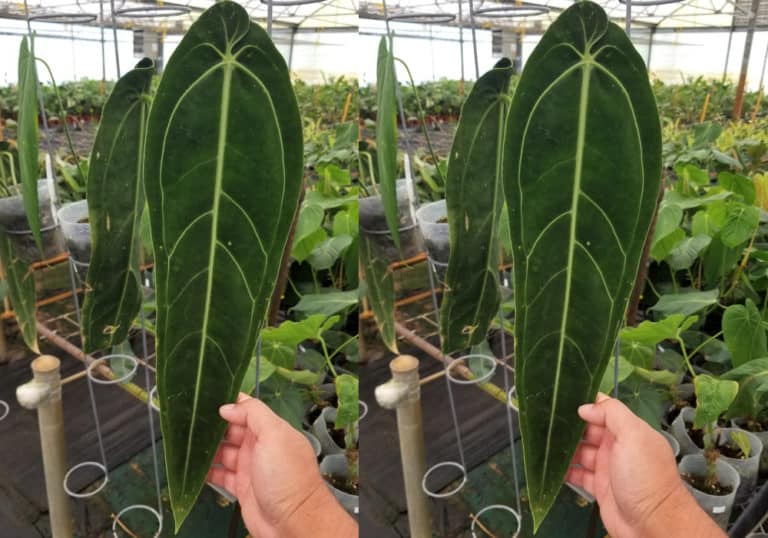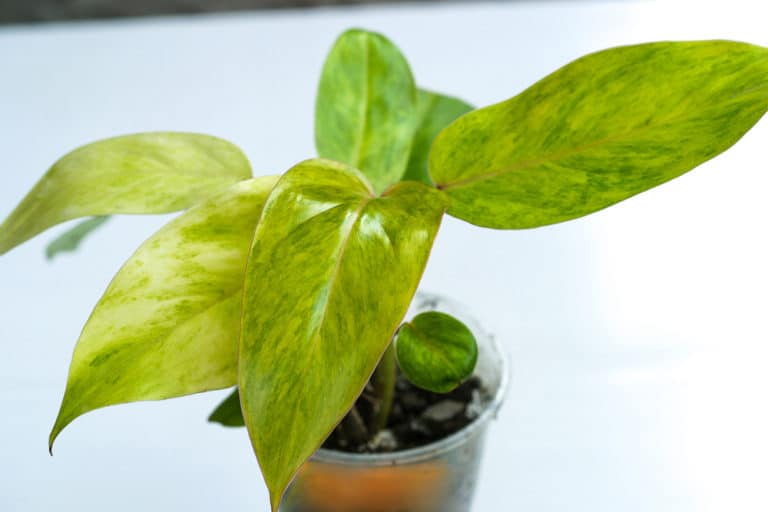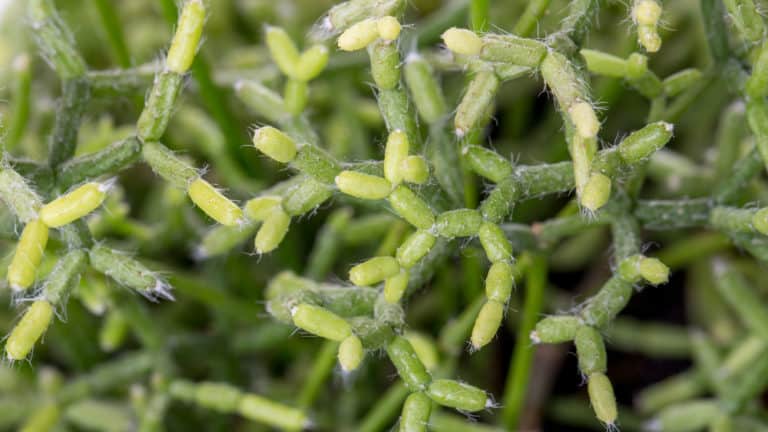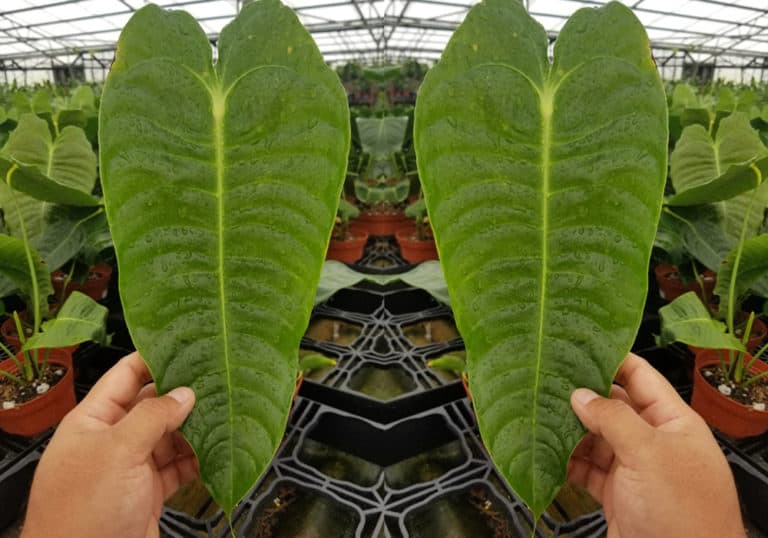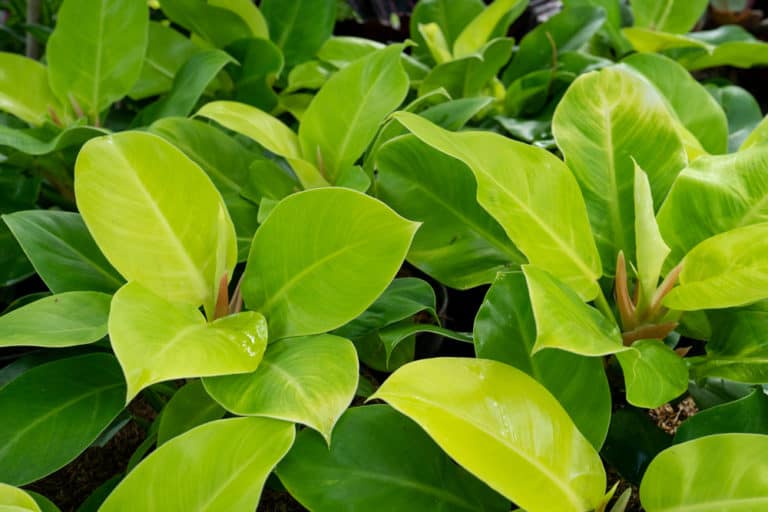Monstera Pinnatipartita Care Guide (2024)
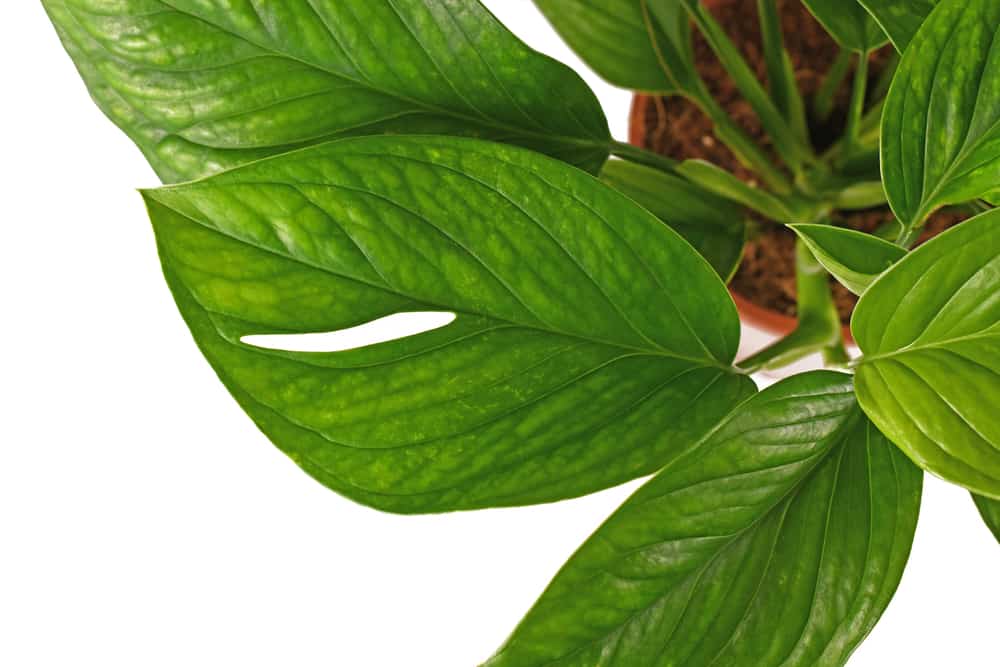
A native of the tropical rainforests, Monstera pinnatipartita has become much in demand as a houseplant.
The pinnatipartita plant is notable for its leaves, which transform as the plant matures, developing deep splits for a frond-like appearance.
If you can provide it with room to grow in a warm, humid environment, it will bring a touch of the tropics to your home.
| Scientific Name | Monstera pinnatipartita Schott |
| Common Name | Monstera pinnatipartita |
| Light | Bright indirect sunlight |
| Watering | Weekly, water if the top half of the soil is dry |
| Temperature | 65 to 80ºF (19 to 25ºC) |
| Hardiness Zone | 10b-12 |
| Humidity | 60-80% |
| Soil Type | Rich, quick-draining, loamy |
| Soil pH | 5 – 7.5pH (moderately acidic to neutral) |
| Fertilizing | A balanced feed once a month in spring and summer |
| Repotting | Every 2-3 years |
| Pruning | During the spring and summer |
| Propagation | Root in water or soil |
| Toxicity | Toxic to humans and pets |
| Mature Size | 4 to 6 feet as a houseplant |
| Bloom Time | Rarely blooms when grown as a houseplant |
What’s Unique About Monstera pinnatipartita?
Monstera pinnatipartita is native to the rainforests of Colombia, Ecuador and Peru. It is a vining plant which loves to climb.
Monstera pinnatipartita plants undergo dramatic changes as they mature. At first, the juvenile leaves are green with a slightly bumpy texture.
At maturity, the leaves develop deep fenestrations from the outside in almost to the center rib, and become smooth and glossy.
The change is so complete that if you have a juvenile plant next to a mature one, you would not know they are the same plant.
Some have confused the Monstera pinnatipartita plant with the Split Leaf Philodendron or Silver Leaf Philodendron, but they are completely different plants.
Monstera pinnatipartita Care
Growing Monstera pinnatipartita is pretty straightforward if you pay attention to the tropical environment where it originates.
Briefly, Monstera pinnatipartita plant care involves providing it with indirect light, warm temperatures, high humidity, and moist soil.
If you can deliver these essentials of pinnatipartita care, you should be able to enjoy this tropical beauty for many years.
Light
In the equatorial rainforests of South America, Monstera pinnatipartita grows under the tree canopy which protects it from the blazing sun.
Thus, in your home Monstera pinnatipartita light requirements are bright indirect sunlight, or between 10,000-20,000 lux.
Accommodating pinnatipartita plant light needs is as simple as finding a spot out of the full sun but still getting lots of ambient light.
A north or east-facing window will give your Monstera pinnatipartita lots of bright light without exposing it to the damaging afternoon sun.
If you must place it in a south or west-facing room, keep it away from the windows in a slightly shady spot.
Watering
In the tropical rainforests, Monstera pinnatipartita is accustomed to frequent rainfall, but the soil drains fairly rapidly.
Monstera pinnatipartita watering should be done only when the top few inches of soil are dry to the touch. If the surface is moist, wait to water pinnatipartita for a few more days.
Another way to meet Monstera pinnatipartite’s watering needs takes a bit of effort to set up, but will keep the soil moist even when you’re away from home.
Set a large jar of water on a shelf or table higher than the soil surface. Take a thick cotton cord and bury it deep in the soil, with the other end in the jar. As the soil dries, water will wick into it from the jar, keeping the soil consistently moist.
Temperature
The Monstera pinnatipartita temperature range is from 65 to 80ºF (19 to 25ºC).
Most homes can easily accommodate the lower end of that range, so no supplemental heat is necessary to provide an acceptable temperature for pinnatipartita plant.
Monstera pinnatipartita has limited temperature tolerance below 50ºF (10ºC), so keep it out of drafts and away from air conditioning vents. Temperatures in that range for any length of time will inhibit growth.
It has no frost hardiness and can be seriously damaged by temperatures below 35ºF (2ºC). If you move your Monstera pinnatipartita outside in the hot summer months, be sure to bring it in before temperatures start to fall.
Humidity
In the rainforest, Monstera pinnatipartita is accustomed to high humidity, and so the ideal humidity for pinnatipartita Monstera is between 60-80%.
It is not possible or advisable to keep your home at that humidity level, so you will need to create a microclimate to meet the Monstera pinnatipartita humidity requirements.
You can buy a small humidifier and place it among the plants to increase the humidity level in their immediate vicinity.
Alternatively, you could place them on a pebbled tray and fill it with water. As it evaporates it will surround the plants with moister air.
Misting the foliage every few days with distilled water will also provide the humidity your Monstera pinnatipartita needs.
Soil
Monstera pinnatipartita soil needs to both retain moisture but drain away excess water. These plants will do best when potted in a soil mix that is loose and porous.
The pH level for Monstera pinna is between 5-7.5, or slightly acidic to neutral. This can easily be obtained with a peat-based soil mix.
To make your own soil for Monstera pinna, combine standard potting mix with perlite and peat moss or coco fiber. Adding some compost will provide extra nutrients for your Monstera pinnatipartita.
If you can find a commercial aroid soil mix, that will be ideal for potting your Monstera pinnatipartita.
Fertilizer
You will need to use fertilizer for pinnatipartita.
You can use a standard houseplant brand for your Monstera pinnatipartita fertilizer. A balanced
fertilizer ratio of 10-10-10 will be fine, but 20-10-10 is optimal for a foliage plant like Monstera pinnatipartita, as the extra nitrogen will boost leaf growth.
If you use a liquid fertilizer, feed the plant once a month during the growing season. Dilute it to half the recommended strength, and apply it to the soil surface shortly after you have watered. This ensures that the nutrients will be absorbed by the soil evenly.
You can also mix fertilizer granules into the soil once at the start of the growing season.
Potting & Repotting
Because of its moderate growth rate, Monstera pinnatipartita repotting only needs to be done every 2 or 3 years.
When the foliage starts to look yellow and curly, and roots can be seen growing out the drainage holes, it’s time for repotting pinnatipartita.
Don’t increase the pot size too much; only increase the diameter by 2 inches at most. Make sure the new pot has good drainage holes.
Use fresh potting soil and water your Monstera pinnatipartita well once you’ve firmed the soil around the roots.
It’s a good idea to put a sphagnum moss pole in the pot at the same time, as Monstera pinnatipartita loves to grow up a support.
Pruning
Most Monstera pinnatipartita pruning is done to remove dead or damaged leaves, but you may need to trim your Monstera pinnatipartita if it starts to take up too much space.
Because it is a vining plant, it can be trained to grow up a pole or trail from a hanging basket, but if it starts to grow too wide, you can remove leaves to create a narrower profile.
When cutting pinnatipartita plant, use a sharp, sterilized knife or pair of scissors. Cut the leaf back to where it joins the main stem. Do not leave the plant material on the soil, but put it in the garbage or compost.
Propagation
The most fool-proof method of Monstera pinnatipartita propagation is to take stem cuttings.
The best time to propagate pinnatipartita Monstera is in spring at the start of its growing season.
Select stems with at least 2 nodes. If possible, find stems with aerial roots to increase your chances of success. Cut them with sharp, sterilized scissors about an inch below the lowest node.
Place the cuttings in either a jar of water or moist soil. Keep them in a warm and humid environment. If in water, change it every few days.
You should see roots within a couple of months. When they’re 2 inches long, plant each rooted cutting out in its own small pot.
Also, make sure to check out our in-depth Monstera albo plant care guide.
Common Problems of Monstera pinnatipartita
Most Monstera pinnatipartita problems can easily be identified and resolved before serious damage to the plant occurs.
Common problems with pinnatipartita include insect infestations and fungal or bacterial diseases caused by too-wet soil.
Regular inspection of your Monstera pinnatipartita leaves will help you catch any problems early before they get out of control.
Pests
Monstera pinnatipartita pests include most of those that commonly attack houseplants. Your pinnatipartita plant will need help to keep these bugs at bay.
Spider mites leave little white or yellow spots on the leaves. Use insecticidal soap or neem oil to eliminate them.
Mealybug eggs look like little cotton puffs on the underside of the leaves. A cotton ball soaked in rubbing alcohol can be used to wipe them off.
Scale resemble brown bumps on the stems. Scrape them off.
Thrips are tiny flying insects that leave their frass (or poop) on the leaves. Insecticidal soap will kill them, and you can use yellow sticky traps to catch any that may turn up in future.
Diseases
Most Monstera pinnatipartita diseases can be prevented by keeping the soil moist but not wet.
However, if your pinnatipartita Monstera does develop a fungal disease, you should be able to save the plant.
If the leaves of Monstera pinnatipartita are starting to turn yellow and the stems are mushy, there’s a good chance you’ve got root rot. Remove the plant from its pot and cut out all blackened roots as well as the affected foliage. Replant in fresh soil mix and cut back on watering.
Yellow and black spots on the leaves indicate a fungal disease. Cut out all affected leaves and dispose of them in the garbage. Spray the plant with a fungicide and water less frequently.
Growing Problems
Other Monstera pinnatipartita growing problems can be caused by not providing optimal growing conditions. If you’ve got a sick plant all you may have to do is review what it needs to thrive.
If foliage is drooping, you may be watering too much or too little. Check the soil and either give it a good drink or replant in fresh potting mix.
Brown tips to the leaves indicate too low humidity. Increase the moisture in the air in its immediate vicinity.
If the leaves have crispy brown edges, your Monstera pinnatipartita is getting too much sun. Move it to a shadier spot.
On the other hand, if the leaves on your mature plant aren’t splitting, you probably need to put it in a brighter spot.
Toxicity of Monstera pinnatipartita
Like all members of the Araceae family, pinnatipartita Monstera contains calcium oxalate, which is toxic to mammals, including humans and most household pets.
Its toxicity level isn’t usually high enough to be fatal, but ingesting any part of the plant can cause a serious reaction, so you should be aware of the potential danger in your home.
For Humans
Monstera pinnatipartita is toxic to humans, but usually causes discomfort rather than a serious reaction.
Children may try eating part of a Monstera pinnatipartita leaf. The taste is unpleasant so they’re unlikely to do more than take a nibble. Clean any plant material from around and inside their mouth, and give them a popsicle to soothe any pain.
However, if they have a swollen tongue or difficulty breathing, take them in for emergency care immediately.
Adults are more likely to get sap on their skin and develop a rash. Wear gloves when handling the plant, and rinse off any sap that gets on your skin.
For Pets
People with pets should take precautions to prevent them from eating Monstera pinnatipartita leaves or stems.
It’s possible to put Monstera pinnatipartita in a hanging planter well out of reach of any animals, or place the pot on a high table or shelf.
You could also place a barrier around the base to prevent access. A clear plexiglass enclosure would also help to keep the air around the Monstera pinnatipartita more humid.
If your cat or dog does manage to take a bite, they may start drooling, vomiting, or wheezing. Do not attempt to treat the symptoms yourself, but take them to the veterinarian immediately.
Monstera pinnatipartita Appearance
The deep fenestrations on the leaves of a mature Monstera pinnatipartita are what make this tropical plant so outstanding.
The Monstera pinnatipartita appearance changes so much as the plant goes from its juvenile to mature stage that they don’t even look like the same plant.
While it rarely if ever flowers, the foliage alone makes it a very desirable houseplant.
Foliage
The foliage of Monstera pinnatipartita undergoes a dramatic alteration as it matures.
In its juvenile stage, the leaves of Monstera pinnatipartita are solid and a little bumpy, sometimes with a silvery pattern.
However, as the plant matures, it unfurls large, pinnate leaves that resemble palm fronds. The deep fenestrations extend almost to the mid-rib and are evenly distributed along the leaf.
Each leaf is a dark, glossy green on top with a medium green underside. They have a leathery texture. The leaf stalks are dark green.
The unfurling of a mature leaf is a fascinating process that can take up to 7 weeks.
Flowering
Monstera pinnatipartita flowering rarely occurs when the plant is grown indoors.
Blooming is more likely when Monstera pinnatipartita is grown outdoors in a tropical climate. It is uncommon for flowers to appear any lower than 8 feet above ground level, and potted plants will not usually reach that height.
When a Monstera pinnatipartita does flower, it produces arum-like inflorescences with a white spathe wrapped around a spadix. The actual flowers are tiny blossoms on the spadix.
Since it is unlikely to appear indoors, it’s best to assume that there will be no flowers. Instead, enjoy the magnificent foliage that is the main attraction of this tropical houseplant.
Size and Growth
In the wild a Monstera pinnatipartita vine can get as long as 33-66 feet with a span of up to 10 feet or more.
However, the size of Monstera pinnatipartita grown as a houseplant is much smaller, with an average height of 4-6 feet. It can become quite bushy unless pruned to a narrower shape.
It has a moderate growth rate and can grow 1-2 feet per year under good conditions.
Monstera pinnatipartita is a vining plant and does best when given support to grow upright. Train it up a sphagnum moss pole, which gives its aerial roots something to grab onto, encouraging healthy growth.
Monstera pinnatipartita Fragrance
The foliage of Monstera pinnatipartita has no fragrance.
While there may be a scent associated with the flowers of Monstera pinnatipartita, they occur rarely in cultivation.
The lack of Monstera pinnatipartita fragrance can be an advantage. In the confined space of a small apartment, for instance, a strongly scented plant could be overwhelming. If someone is sensitive to fragrances, an unscented plant is a good choice.
This also makes Monstera pinnatipartita suitable for use in public spaces where fragrant plants are discouraged, such as nursing homes.
If you want the strong visual interest of Monstera pinnatipartita, but also enjoy fragrant plants, include some flowering plants in your indoor garden.
Suggested Uses for Monstera pinnatipartita
Finding the right spot indoors for a Monstera pinnatipartita plant depends on where you’ve got the right conditions for its healthy growth.
In a south-facing room, tucking it into a corner out of the full sun can create a strong vertical element when it’s trained up a pole.
You could also place it on a high shelf in your bedroom and let the leaves trail down out of reach of any pets. Monstera pinnatipartita filters contaminants such as formaldehyde out of the air.
Even in temperate zones, you can move your Monstera pinnatipartita pot out to a shady spot on the patio to enjoy steamy summer weather.
FAQ
What is Monstera pinnatipartita?
Monstera pinnatipartita is a vining evergreen plant native to the equatorial rainforests of South America. It is grown as a houseplant for its distinctive leaves.
How to identify Monstera pinnatipartita?
Monstera pinnatipartita has two forms. Its juvenile leaves are solid with a rough texture, while mature leaves are deeply fenestrated with a glossy texture.
How to care for Monstera pinnatipartita?
Monstera pinnatipartita should be kept out of direct sunlight in a warm, humid environment with regular light watering to maintain moist soil. Fertilize monthly.
How to grow Monstera pinnatipartita indoors?
Monstera pinnatipartita can be grown indoors as a potted plant in well-draining soil. Keep it in bright, indirect light with high humidity and warm temperatures.
How to grow Monstera pinnatipartita outdoors?
Monstera pinnatipartita can be grown outdoors in climate zones 10b and above. Plant it in well-draining soil in light shade and provide support as it climbs.
How fast does Monstera pinnatipartita grow?
Monstera pinnatipartita can grow 1-2 feet a year when grown as a houseplant. Outdoors, a plant grown in the ground will take up to 10 years to reach its full size.
How tall does Monstera pinnatipartita grow?
Monstera pinnatipartita grown as a houseplant will reach a mature height of 4-6 feet. Grown outdoors, a vine can reach 60 feet or more in length.
How to make Monstera pinnatipartita grow faster?
Monstera pinnatipartita will grow its fastest when staked with a sphagnum pole and grown in warm temperatures, with high humidity, regular fertilizing, and bright, indirect light.
How to stake Monstera pinnatipartita?
Monstera pinnatipartita is a vining plant and should be staked with a sphagnum moss pole, which will give its aerial roots some nourishment as it grows upward.
How to pot Monstera pinnatipartita?
Monstera pinnatipartita should be potted in a container with good drainage in a porous soil mix. Repot every 2 or 3 years to keep it from getting rootbound.
How to revive Monstera pinnatipartita?
If your Monstera pinnatipartita soil has dried out completely, completely soak the soil by placing it in a sink or bucket. Let the excess water drain out.
Why is my Monstera pinnatipartita dying?
Your Monstera pinnatipartita may have a fungal disease. If the soil is too wet, remove the plant from its pot and cut away all damaged roots and foliage. Replant in fresh soil.
Why is my Monstera pinnatipartita drooping?
Check your Monstera pinnatipartita’s soil. If it’s too dry, water it slowly several times until the soil is thoroughly moistened. If it’s too wet, replace the soil mix and cut back on watering frequency.
How cold can Monstera pinnatipartita tolerate?
Monstera pinnatipartita can tolerate temperatures as low as 35°F (2°C) for very brief periods, but it will not grow well below 65°F (18°C). Freezing temperatures will kill it.
How to get rid of pests on Monstera pinnatipartita?
Monstera pinnatipartita can usually be controlled with insecticidal soap, neem oil, or alcohol. Identify the insects and use the most effective method to control them.
Is Monstera pinnatipartita toxic to cats?
Yes, Monstera pinnatipartita is toxic to cats. If your feline has eaten some of its foliage and starts vomiting, drooling, or wheezing, seek immediate veterinary care.
Is Monstera pinnatipartita toxic to dogs?
Yes, Monstera pinnatipartita is toxic to dogs. If your dog starts drooling excessively, vomiting or wheezing, and has a swollen tongue, take him to the veterinarian immediately.
Is Monstera pinnatipartita toxic to children?
Yes, Monstera pinnatipartita is toxic to children. If a child has eaten any part of the plant and has a swollen tongue or difficulty breathing, take them to emergency immediately.
Is Monstera pinnatipartita toxic to humans?
Yes, Monstera pinnatipartita is toxic to humans. If you get some of the sap on your skin, it may become irritated. Rinse all affected areas and use a topical cream.
Does Monstera pinnatipartita have a scent?
The leaves of Monstera pinnatipartita have no scent, and it flowers rarely if ever when grown indoors as a potted plant. Essentially it is a fragrance-free houseplant.

